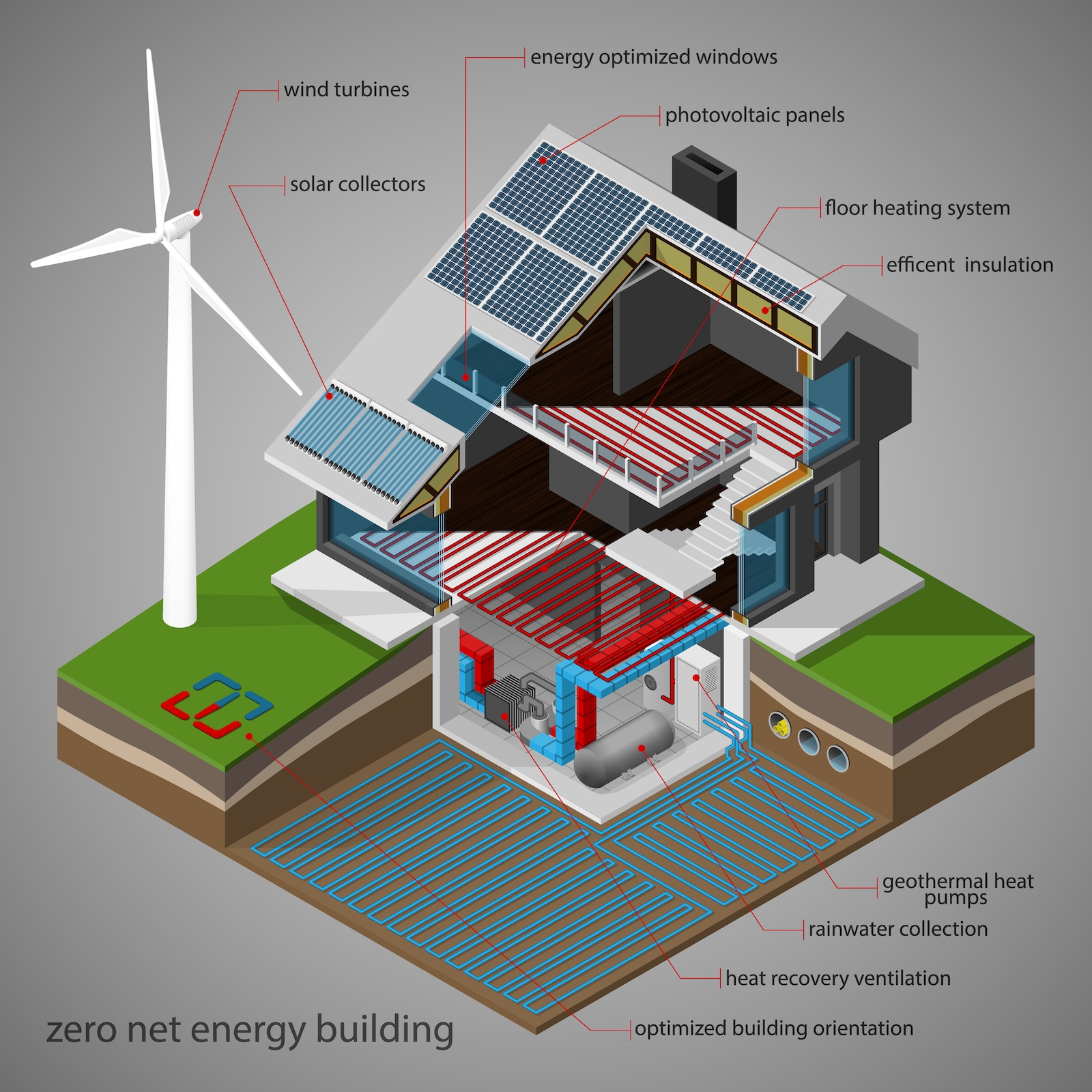
Learning about Net Zero
Definitions
As the "net zero energy" and "zero net energy” concepts are relatively new, there are not yet definitive, widely accepted zero-energy metrics. The Department of Energy (DOE) and the National Renewable Energy Laboratory (NREL) have spearheaded much of the work on net zero energy buildings to date. NREL presents several definitions for "net zero energy", and they encourage building designers, owners, and operators to select the metric that best fits their project. The NREL publication Zero Energy Buildings: A Critical Look at the Definition (PDF 477 KB) explores definitions in detail, and it suggests four ways in which net zero energy may be defined:
Net Zero Site Energy
Net Zero Source Energy
Net Zero Energy Costs
Net Zero Energy Emissions
Site Energy refers to the energy consumed and generated at a site (e.g. a building), regardless of where or how that energy originated. In a net zero site energy building, for every unit of energy the building consumes over a year, it must generate a unit of energy.
Source Energy refers to the primary energy needed to extract and deliver energy to a site, including the energy that may be lost or wasted in the process of generation, transmission, and distribution. For example, a coal-burning power plant may generate 1 Joule of electricity for every 3 Joules of energy in the coal consumed. If natural gas is used at a site, for every 20 Joules consumed, 1 Joule may be needed to extract and distribute the gas to the site. Metrics for net-zero source energy buildings account for these factors, though exact metrics can vary depending on site and utility factors.
Net Zero Energy Cost is perhaps the simplest metric to use: it means that the building has an energy utility bill of $0 over the course of a year. In some cases, building owners or operators may take advantage of selling Renewable Energy Credits (RECs) from on-site renewable generation.
Many conventional energy sources result in emissions of carbon dioxide, nitrogen oxides, sulfur dioxide, etc. A Net Zero Energy Emissions building either uses no energy which results in emissions or offsets the emissions by exporting emissions-free energy (typically from on-site renewable energy systems).
Grid Connection and Net Zero
Most Net Zero Energy Buildings are still connected to the electric grid, allowing for the electricity produced from traditional energy sources (natural gas, electric, etc.) to be used when renewable energy generation cannot meet the building's energy load. When, conversely, on-site energy generation exceeds the building energy requirements, the surplus energy should be exported back to the utility grid, where allowed by law. The excess energy production offsets later periods of excess demand, resulting in a net energy consumption of zero. Due to current technology and cost limitations associated with energy storage, grid connection is usually necessary to enable the Net Zero Energy balance. Differences in how utilities and jurisdictions address payment for energy that is exported from the building into the grid can impact project economics and should be carefully evaluated.
Energy Efficiency
Regardless of the definition or metric used for a Net Zero Energy Building, minimizing the energy use through efficient building design should be a fundamental design criterion and the highest priority of all NZEB projects. Energy efficiency is generally the most cost-effective strategy with the highest return on investment, and maximizing efficiency opportunities before developing renewable energy plans will minimize the cost of the renewable energy projects needed. Using advanced energy analysis tools, design teams can optimize efficient designs and technologies.
Energy efficiency measures include design strategies and features that reduce the demand-side loads such as high-performance envelopes, air barrier systems, daylighting, sun control and shading devices, careful selection of windows and glazing, passive solar heating, natural ventilation, and water conservation.
Once building loads are reduced, the loads should be met with efficient equipment and systems. This may include energy-efficient lighting, electric lighting controls, high-performance HVAC, and geothermal heat pumps. Energy conversion devices such as combined heat and power systems, fuel cells, and microturbines do not generate renewable energy. Instead, they convert fossils fuel energy into heat and electricity and are can be considered energy efficiency strategies.
Renewable Energy
On-Site Renewable Energy
Once efficiency measures have been incorporated, the remaining energy needs can be met using renewable energy technologies. Common on-site electricity generation strategies include photovoltaics (PV), solar water heating, and wind turbines.
Renewable, on-site thermal energy can sometimes be provided by effective use of biomass. Wood, wood pellets, agricultural waste, and similar products can be burned on-site to provide space heating, service water heating, etc. Biofuels, such as biodiesel, may also be used in conjunction with conventional fossil fuels to meet thermal loads. More background on biomass is available in the Alternative Energy page.
Priority should be given to renewable approaches that are readily-available, replicable, and most cost-effective. System maintenance must also be given consideration to over time. Life-cycle cost analysis should be used to evaluate the economic merits of various systems over their usable lifetimes.
Off-Site Renewable Energy
Depending on the NZE metric and guidelines used, buildings may be permitted to use energy generated off-site to offset the energy used in a building. If space is limited, a facility owner may install dedicated wind turbines, solar collectors, etc. at a separate location. Most often, however, credit for off-site renewable generation is gained by purchasing renewable energy credits (RECs).
RECs are available from many renewable energy technologies. Large, utility-scale wind farm, solar plants, geothermal plants, and hydropower facilities generate electricity without using fossil fuels or primary energy. The costs of constructing and operating these generation facilities are often paid for by selling the "credit" for generating energy renewably (as well as selling the energy itself). The structure and market for RECs are evolving and it varies regionally.
For more information, call (323) 646-2534 or email us at info@buildingdoctors.com
